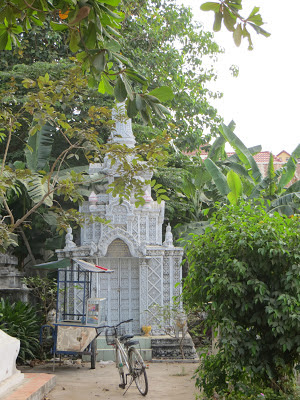The temples of
Phnom Penh are lonely places.
They lack the
glittering tiles and gilded facades of neighboring Thailand. They are painted in flat creams and beiges
and are lost among the hasty construction of a developing city.'
Although
ninety-five percent of Cambodians practice Buddhism, the majority of temples I
have wandered into across the city are almost entirely devoid of worshipers.
When I lived in
Thailand one could not walk a block in the city without stumbling upon a temple
and, while the temples were packed only on major religious holidays, the temple
doors were always open, and the insides always elaborately covered in red
carpeting, murals and displays of towering gilded and wood carved Buddhas. On any day there could always be found a few
families or old woman bearing offerings.
But here in
Phnom Penh the doors to many temples remain shut. Gates have been erected around them, some
locked. The courtyards go un-swept and
often double as extra storage space for dusty bags of cement and bamboo scaffolding
for construction projects.
I have stayed
for a time on the edge of one such courtyard, sitting on the worn wooden steps
leading up to a young man’s shack. The
young man, who turned out to be a mechanic and repairman of sorts, had invited
me to rest and we spoke briefly in my broken Khmer, while looking out through
palm fronds on the cracked tiles, piles of debris and gilded lion statues.
This past
December the New York Times ran an article analyzing the declining relevance of
Buddhism in Thailand. “The temples were
once the heart of village life, serving as meeting places, guesthouses and
community centers. But many have become little more than ornaments of the past,
marginalized by a shortage of monks and an increasingly secular society.”
In Cambodia, the
decline is far starker.
During their
four years of genocide, the Khmer Rouge targeted – among other groups – monks,
effectively exterminating almost the entire religious order. They did away with wats as well, destroying most of them and converting the remaining few
into arsenals, prisons and execution yards. At the temples of Angkor, bullet holes have
added a layer of violent carving atop the12th Century dancing Apsara reliefs.
Like many
aspects of Cambodian society, temples are still in the midst of a slow
recovery. Thailand’s robust religious tradition
never suffered direct attack and yet still religious relevance is waning with
the influences of modernity. It is hard
to predict the fate of the temples of Phnom Penh. It is hard to guess whether the bags of
cement and poles of scaffolding filling the courtyards of pagodas will be used
to repair the past or continue upwards, constructing more skyscrapers,
storefronts and apartment buildings.
http://www.nytimes.com/2012/12/19/world/asia/thai-buddhist-monks-struggle-to-stay-relevant.html?smid=fb-share&_r=0





No comments:
Post a Comment